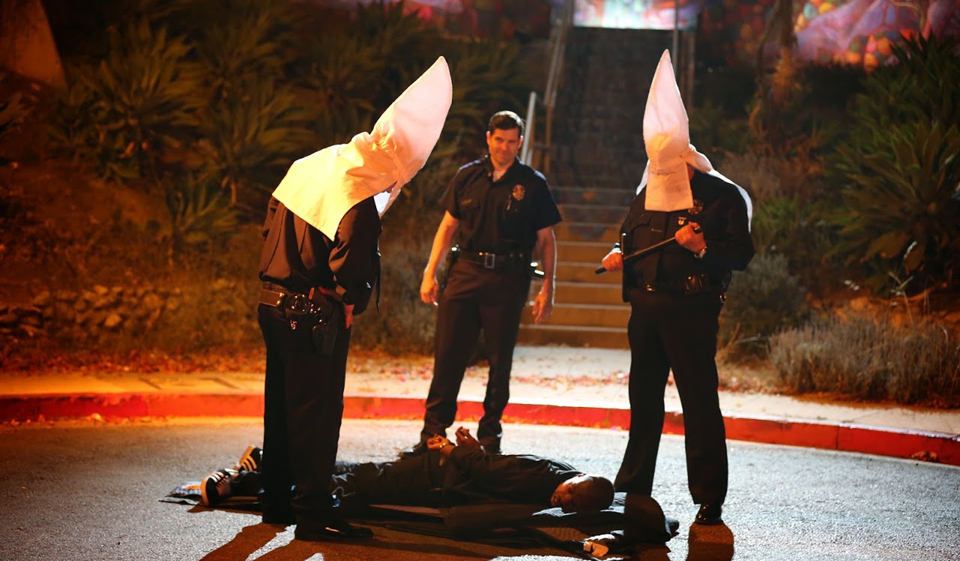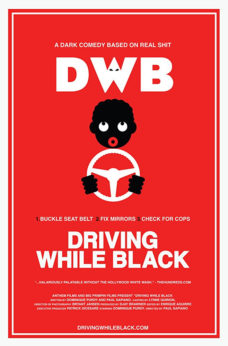
English art historian and writer Horace Walpole once famously said, “The world is a tragedy to those who feel, but a comedy to those who think.” But it can be argued that no one person is of so singular a mind that they can’t go between feeling and thinking when looking at the issues that make our society what it is. That quote came to my mind when viewing the film Driving While Black. The movie interweaves humor into the seriousness of Black people dying at the hands of police officers, purposefully stirring emotions in viewers and having them question if it is a tragedy or comedy they are watching. The conclusion is that this film is both—and it does a fine job of existing within that duality.
Filmmaker Paul Sapiano brings us a movie based on the real-life experiences of writer and lead actor Dominique Purdy. It dramatizes Purdy’s life growing up as a Black man in Los Angeles, and his various run-ins with the LAPD. Purdy plays Dmitri, who works as a pizza delivery guy, but has hopes of doing more with his art. Dmitri is offered a job as a Hollywood “star tour” bus driver, and all he has to do is make it to his interview in order to secure his employment. Yet every time he attempts to go to his job interview, he keeps having unfortunate encounters with the cops. As viewers follow Dmitri in his week of trying to make it to the interview, we are treated to a slice of life of a working-class Black man in Los Angeles, the viewpoints of various police officers, and an overall tale of what over-policing can do to a city and to individuals living under it.
Studies have shown that Black men are three times as likely to die from police use of force than white men. The average rate at which police officers are likely to use force against Black Americans is 3.6 times more than the average rate against whites. A San Diego study of traffic enforcement stops, by researchers at San Diego State University, showed results that in 2014, when a driver’s race was visible, Black drivers were twenty percent more likely to be stopped by police. Jordan Edwards and DeJuan Guillory are just two names of Black men killed by police in 2017. More than 250 Black people were killed by police in 2016 alone.
Suffice to say, there is a serious issue when it comes to the lives and safety of Black men when dealing with the police. The movie is timely, and offers a variety of perspectives regarding the topic.
The most prominent viewpoint is that of the main character Dimitri. Through a series of flashbacks, coupled with cop interactions throughout the week, we get a firsthand view of why he has come to be truly afraid whenever he is stopped by the cops. The opening scene of the movie is an elaborate nightmare that plays much like a horror movie, the white officer being the “monster” as Dmitri is accosted by officers in KKK hoodies. This sets the tone for the underlying fear that will occur with every interaction Dmitri and his friends have with the LAPD throughout the film.
This is an important theme to note for the movie, because no matter how many jokes, or occasional laugh-out-loud moments occur, it seems purposeful that when a Black man has an interaction with the police the scene is directed with an undercurrent of fear and foreboding. The jokes don’t necessarily stop during these interactions, but the understanding that at any moment one of these Black men could be shot and killed is always at the forefront—and that isn’t taken lightly.
As Dmitri explains, as a Black man he has to deal with an “extra layer of bullshit” in addition to the struggles of working for a living. The extra layer of bull he refers to is racism and the harassment by the police. In one scene, after he delivers a pizza to a Black elder, both characters sit down to watch a video of a Black man being shot down by a group of police officers. The older man states, “All this shit is routine” as he watches the video. There are subtle yet stand-out moments where the Black characters police themselves for fear of being pulled over by the police or worse. Moments like these throughout the film summarize the state of constant alert Dmitri, and others like him, exist in while trying to pursue some sense of normalcy.
Aside from the focus on Dmitri, we see a variety of police officer types. There are Black officers, gay officers, women officers, and other officers of color, along with white officers. The film not only shows their interactions with Dmitri, but their interactions with each other.

We are shown the struggle of the woman officer, who is also Filipina, the space she occupies as a woman of color on the police force, and the discrimination she faces. We also see the ridicule the officer who happens to be gay deals with from some of his colleagues. Then there are the Black officers and how some attempt to help Dmitri stay out of trouble, while others hold him and his friends in contempt. None of the police officers with plot lines are painted as either complete villains or “good cops,” but rather layered in an attempt to humanize the topic and show its complexities. Even the out and out racist cop has moments where it’s clear the filmmakers want us to understand his motivations, even if we don’t agree with him.
One glaringly missing aspect of the film is any notable visibility of Black women. We only hear about Dmitri’s mother through a text message she sends, while the other main women characters, although women of color, are not African-American. This seems like a missed opportunity, given that not only are Black mothers usually at the forefront of fighting against police brutality due to losing children to police violence, but Black women also suffer abuse by the police at high rates as well. Those voices could have made for a more rounded story.
As the Oscar-nominated film Get Out used the horror genre to show the true viciousness of racism in the United States, so too does Driving While Black insert comedic moments into a most horrifying condition. We live in a time when many Black men, and women, still fear for their lives whenever they are pulled over while driving. Perhaps because I am a Black woman, I always felt a sense of dread whenever the cops stopped Dmitri, that at any moment something could go wrong. This may not be the same response for someone who is not Black watching the film, which may incite other emotions and thoughts. But that in and of itself is what makes this movie well done. It will get people talking.
The humor comes from realizing the ridiculousness of racism and how it still exists in the United States, and from the ways in which these characters try to find little moments of happiness. The despair is feeling like there’s no way we will ever truly escape the violence and suffering. It’s shown as a constant cycle, perhaps a metaphor for life. Overall Driving While Black is an enjoyable movie that draws a fine line down the middle of the road between comedy and tragedy.
Driving While Black hits theaters across the U.S. on February 1. The trailer can be viewed here.










